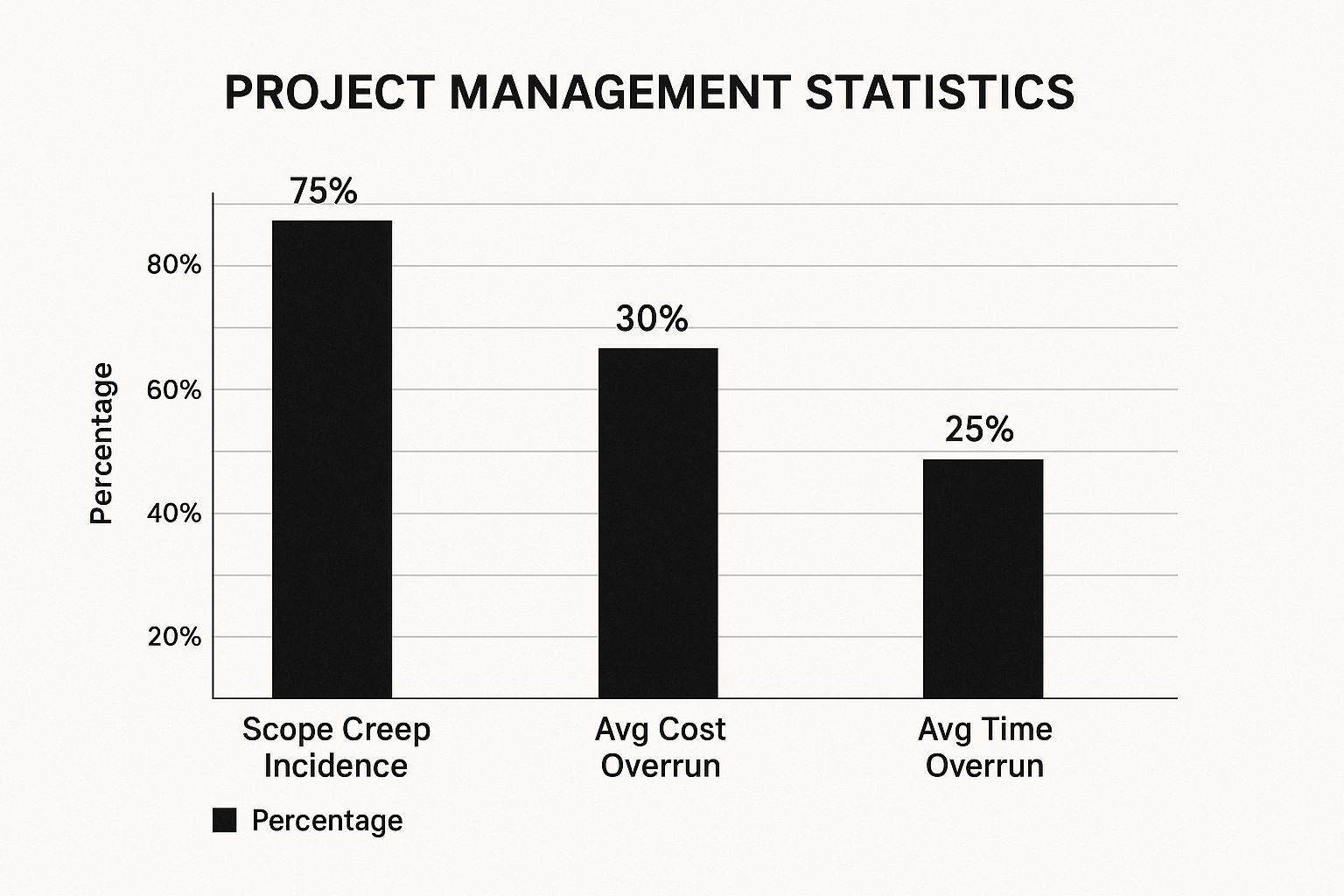The Hidden Cost of Scope Creep: Why Projects Derail

The infographic above illustrates how widespread scope creep is, along with its impact on project costs and timelines. The data shows that 75% of projects experience scope creep. This results in an average cost overrun of 30% and an average time overrun of 25%. These numbers highlight the significant consequences of uncontrolled changes.
Imagine building a house and deciding mid-construction to add another room. This seemingly minor change impacts the blueprints, material orders, and the entire construction schedule. Ultimately, both the budget and the completion date are affected.
This simple example demonstrates how even small additions can create significant delays and increased costs.
Understanding Scope Creep
Successfully managing a project requires keeping scope creep under control. This involves understanding the crucial difference between scope evolution and scope creep. Scope evolution refers to planned and controlled adjustments. Scope creep, on the other hand, describes uncontrolled and often undocumented changes.
Think of it like gardening. Pruning and fertilizing (scope evolution) help your garden thrive. Uncontrolled weeds (scope creep), however, can choke the life out of your plants.
Scope creep presents a major challenge in project management. A prime example is the Denver International Airport's automated baggage handling system. Over 2,000 design changes resulted in a nearly two-year delay and a doubled budget. In 2018, the Project Management Institute (PMI) reported that 52% of all projects experience scope creep. Learn more about scope creep and its impact here.
The Domino Effect of Scope Creep
Scope creep isn’t just a budget problem. It creates a domino effect, impacting team morale, client relationships, and project deadlines. This can decrease productivity, compromise quality, and even lead to project failure. Improved reporting, particularly through tools like financial reporting automation, can help prevent these negative consequences.
Early Warning Signs of Scope Creep
Recognizing the early warning signs of scope creep is essential. The following are some key indicators:
- Vague or changing requirements: Unclear or constantly shifting project goals create a breeding ground for scope creep.
- Lack of documentation: Without proper documentation of changes, it becomes difficult to track the project's progress and maintain control.
- Poor communication: Inadequate communication among stakeholders can lead to misunderstandings and unwanted additions to the project scope.
Addressing these red flags early on can prevent projects from going off track. Learn more about controlling project scope. Effective scope management requires proactive planning, clear communication, and a robust change control process. This involves establishing clear procedures for requesting, evaluating, and approving changes, ensuring any deviation from the original scope is carefully considered and documented.
The following table summarizes some common types of scope creep:
Common Types of Scope Creep
An overview of different manifestations of scope creep across project environments
| Type of Scope Creep | Description | Warning Signs | Impact Level |
|---|---|---|---|
| Feature Creep | Adding new features or functionalities not originally planned. | Requests for "small" additions, expanding functionality beyond initial specifications. | Low to High (depending on the complexity of added features) |
| Requirement Creep | Changes or additions to the project requirements after they have been approved. | Unclear initial requirements, evolving stakeholder needs. | Medium to High |
| Gold Plating | Exceeding the agreed-upon deliverables by adding unnecessary enhancements. | Team members adding features they think are beneficial without stakeholder approval. | Low to Medium (can impact budget and timeline) |
| Scope Leap | A significant change or expansion of the project scope, often involving a fundamental shift in direction. | Major changes in project goals or objectives, significant revisions to project plans. | High |
This table highlights the various forms scope creep can take, from minor feature additions to significant changes in project direction. Understanding these different types can help project managers identify potential problems and take proactive steps to mitigate them. By implementing robust scope management practices and recognizing the warning signs early on, project teams can significantly reduce the risk and impact of scope creep.
Beyond Budgets: The True Impact of Unchecked Changes

Scope creep doesn't simply drain your project's budget. It sets off a chain reaction that can undermine the entire project. While budget overruns are a clear consequence, the less obvious impacts of scope creep are often more damaging.
These hidden costs include diminished team morale, damaged client relationships, and a tarnished company reputation. Addressing these issues proactively is crucial for long-term project and organizational success.
The Ripple Effect on Teams and Clients
Imagine a software development team diligently following a project plan. Then, a client requests a "small" feature addition. This seemingly minor change triggers a cascade of adjustments. The team must rework designs, rewrite code, and extend testing phases. This disrupts their workflow, increases pressure, and can lead to burnout.
Constantly shifting goals also create frustration and impact team morale, making it hard to maintain project momentum. A well-defined creative brief can help mitigate these issues from the start.
Furthermore, scope creep strains client relationships. While clients might initially be excited about new features, delays and cost overruns quickly dampen enthusiasm. This erosion of trust can damage future collaborations and negatively affect your company's reputation.
The Hidden Costs: Beyond Monetary Value
The consequences of scope creep extend beyond project timelines and budgets. According to the PMI's 2018 Pulse of the Profession, 52% of projects experience scope creep. This can significantly reduce the return on investment (ROI).
Studies suggest that projects with substantial scope increases can experience an ROI reduction of 50% or more compared to initial projections. This decrease in ROI is due to higher development and implementation costs, delayed returns, and increased long-term maintenance expenses. Scope creep can also hinder market competitiveness because of delayed product launches.
Beyond the financial repercussions, consider the opportunity cost. Resources allocated to address scope creep could be used for other valuable projects. This can indirectly hinder a company's growth and stifle innovation.
Compromised quality often accompanies scope creep. When teams are rushed to meet adjusted deadlines, the quality of deliverables may suffer. This further damages client relationships and company reputation. Learn more about how scope creep affects project success.
Building a Case for Scope Discipline
Understanding the broader implications of scope creep builds a strong case for rigorous scope management. By highlighting the hidden costs and potential long-term damage, project managers can advocate for realistic planning and controlled change processes. This proactive approach protects not only the budget, but also team morale, client relationships, and the overall project's success.
Building Your Scope Fortress: Prevention That Works

Preventing scope creep is much more effective than trying to manage it after it’s taken root. Think of it as building a "scope fortress" around your project right from the start. This proactive method means establishing clear boundaries and open communication channels from day one. The ultimate goal? A project environment that's resistant to uncontrolled changes. Learn more in our article about project management for creatives.
Crafting a Crystal-Clear Scope Statement
The cornerstone of any scope fortress is a well-defined scope statement. This crucial document serves as the project's guiding document, outlining the project’s goals, deliverables, and boundaries. It becomes the go-to reference point for all stakeholders, minimizing misunderstandings and conflicting expectations.
For instance, imagine a website redesign project. The scope statement would detail the number of pages, essential functionalities, and design elements included. It's like a contract everyone agrees to.
The scope statement should also explicitly define what is not included. This helps avoid assumptions and prevents stakeholders from requesting additions later, keeping the project focused.
Visualizing the Boundaries: Work Breakdown Structure (WBS)
A Work Breakdown Structure (WBS) offers a visual representation of the project scope. It breaks down the project into smaller, manageable tasks. This visual approach makes it easier for everyone involved to understand the project’s defined boundaries.
Imagine a marketing campaign. A WBS might include market research, content creation, social media promotion, and performance analysis. Each task can then be further divided into subtasks, creating a detailed view of the project. This detailed breakdown provides transparency and clarity for the entire team.
Stakeholder Education and Alignment
Even the most comprehensive scope statement is ineffective if stakeholders don't understand it. That’s why stakeholder education is essential. This means proactively communicating the scope statement and WBS to everyone, ensuring they understand the project’s boundaries.
Regular meetings, clear explanations, and answering any questions are all crucial for successful stakeholder education. A requirement prioritization framework can also help stakeholders understand the inherent trade-offs in any project. This framework involves prioritizing different project requirements, allowing informed decisions about inclusions and exclusions.
This collaborative approach aligns everyone’s expectations from the beginning, fostering a shared understanding of the project scope. This shared understanding acts as a powerful defense against potential scope creep, creating a strong team culture dedicated to respecting the established boundaries.
Practical Techniques for Scope Visualization
Visual tools can often communicate project boundaries more effectively than documents alone. Tools like Gantt charts and Kanban boards offer a dynamic view of the project scope. They simplify progress tracking and demonstrate the impact of any proposed changes.
These visual aids make the project scope more concrete and accessible, acting like a shared dashboard that displays the project’s status and potential roadblocks. By implementing these preventative measures, project teams can establish a proactive defense against scope creep, ensuring projects stay on track and within budget.
The Change Control Playbook: Managing Inevitable Shifts
Change is a constant in project management. Even with the best planning, unexpected shifts can occur. This section explores how experienced project managers handle these changes, turning potential scope creep into controlled project evolution. They don't fear change; they use it to refine and improve the project.
Establishing a Change Request Protocol
Managing change starts with a clear change request protocol. This process should be simple and accessible to everyone involved. It begins with a formal request explaining the proposed change, its reasons, and potential project impact.
This isn't about restricting creativity, but about managing it effectively. A simple form can capture change requests, ensuring all the key information is documented from the start. This documentation is the foundation of a controlled change management process.
Evaluating Change Requests: Separating Value from Creep
Submitted change requests need evaluation. This is where defined criteria are essential. These criteria should align with project objectives and consider the impact on budget, timeline, and resources.
This evaluation separates valuable additions from actual scope creep. For example, if a client requests a minor website design change, is it essential for functionality or user experience, or just an aesthetic preference? This determines the request's true value. Implementing preventative measures can help avoid scope creep. Check out this article on strategies to maximize equipment uptime while minimizing costs for more on preventing unwanted changes.
The Impact Analysis: Thinking Beyond the Immediate
Effective impact analysis is crucial. It involves assessing not only the immediate effects of a proposed change but also its long-term consequences.
Imagine adding a new feature to software. The immediate impact might seem small, but it could affect other functions, testing, and even the release date. A broad perspective helps anticipate problems and inform choices. Scope creep is a common issue in construction. As of 2023, 80% of construction projects with scope creep experience schedule delays. These delays average 33%, significantly impacting timelines and budgets. More detailed statistics can be found here.
To illustrate the various change control approaches and their effect on scope creep, let's take a look at the following comparison:
Change Control Process Comparison
| Process Element | Basic Approach | Advanced Approach | Benefits | Implementation Difficulty |
|---|---|---|---|---|
| Request Submission | Informal email/verbal | Formal documented request | Reduced miscommunication, clearer history | Low |
| Evaluation Criteria | Loosely defined, subjective | Clearly defined, objective, tied to project goals | Consistent decision-making, easier prioritization | Medium |
| Impact Analysis | Limited, focused on immediate effects | Comprehensive, considers downstream impacts | Proactive risk mitigation, improved planning | High |
| Approval Process | Ad-hoc, often by a single person | Structured review process, multiple stakeholders involved | Increased accountability, better decisions | Medium |
| Documentation | Minimal or nonexistent | Detailed records of all changes and their rationale | Improved traceability, reduced disputes | Low |
This table highlights the key differences between a basic and an advanced approach to change control. While a basic approach may be suitable for smaller, less complex projects, an advanced approach provides a more robust framework for managing change and minimizing the negative effects of scope creep, particularly in larger and more complex endeavors.
Documentation and Communication: Maintaining Transparency
Clear documentation is essential throughout change control. Every approved change, its impact assessment, and the reasons for approval should be recorded.
This documentation protects both the client and the team. Transparent communication about approved changes builds trust and keeps everyone informed. Regular updates, clear explanations, and open communication keep everyone aligned, fostering collaboration and minimizing misunderstandings. This turns potentially disruptive changes into manageable adjustments, contributing to project success and client satisfaction. Learn more about client communication best practices.
Mastering Difficult Conversations: Negotiation Tactics That Work
Managing project scope creep often involves navigating challenging conversations. This requires strong negotiation skills to maintain positive client relationships while upholding project parameters. Effectively communicating project boundaries and the potential impact of changes is essential. Successfully navigating these conversations is key to project success and client satisfaction.
Responding to Scope Expansion Requests
Clients often request additional features or functionalities. Successful project managers respond strategically, not defensively. Instead of an immediate "no," acknowledge the client's needs and explore the request's value. This demonstrates a collaborative approach, building trust and fostering open communication. You might be interested in: How to master client communication best practices.
For example, if a client wants a new feature, a project manager could say, "I understand the value of this addition. Let's explore its potential impact on the project timeline and budget." This opens a discussion, rather than shutting down the request.
Redirecting Feature Enthusiasm
Instead of dismissing new feature ideas, redirect enthusiasm towards future project phases. This acknowledges the client's vision while maintaining the current project's scope. This approach demonstrates long-term thinking and commitment to client goals, strengthening the relationship.
Present a roadmap outlining how future phases can accommodate these additional features. This provides a tangible plan, turning potential scope creep into managed future development.
Negotiating Project Boundaries
Sometimes, clear communication about project limitations is necessary. These conversations can be delicate, requiring a diplomatic approach. Frame the discussion around the trade-off principle. Explain how expanding the scope in one area necessitates reductions or adjustments elsewhere. This transparent approach helps clients understand the implications of their requests.
Additionally, present alternative solutions that address client needs without exceeding project boundaries. This demonstrates problem-solving skills and a commitment to finding mutually beneficial solutions. This could involve suggesting simplified versions of a feature or proposing alternative functionalities within the existing scope.
Data-Driven Negotiation
Support your position with data. Present clear metrics demonstrating the potential impact of scope changes on the project timeline and budget. This provides an objective basis for the discussion, strengthening your argument.
For instance, showing how a requested feature would add two weeks to the development timeline and increase the budget by 10% provides concrete evidence. This data-driven approach fosters understanding and informed decision-making.
Presenting Alternatives
Offering alternative solutions is crucial for successful negotiation. This allows clients to achieve their desired outcomes without derailing the project. These alternative options could include:
- Phased Implementation: Breaking down large features into smaller, manageable components implemented across different project phases.
- Value Engineering: Finding less expensive ways to achieve the desired functionality without compromising quality.
- Prioritization: Collaboratively ranking desired features with the client, ensuring the most valuable additions are implemented first.
By mastering these negotiation tactics, project managers transform potentially difficult conversations into opportunities for collaboration and successful scope management. This proactive approach strengthens client relationships, keeps projects on track, and delivers successful outcomes.
Technology Arsenal: Tools That Actually Prevent Scope Creep

Let's move past the usual project management software suspects. We're diving into the specific tools that truly combat scope creep. Forget the marketing hype; these are the technologies proven effective in managing real-world projects.
Requirement Management Systems: Setting Boundaries From the Start
Requirement Management Systems (RMS) are key to establishing clear project boundaries. They go beyond simple documentation. RMS allows teams to define, track, and manage every project requirement. Think of it as a central hub for all project needs.
RMS can also generate automated alerts. These alerts trigger when proposed changes threaten to expand the project beyond its defined scope. This early warning system lets project managers address potential scope creep proactively. It's like having a virtual fence around the project, preventing uncontrolled growth.
Visualization Tools: Communicating Scope Clearly
Visualization tools give everyone a clear view of the project scope. This makes it easier to understand the project's boundaries. Tools like Gantt charts and Kanban boards transform complex project plans into easy-to-understand visuals.
These tools offer more than static documents. They provide a dynamic look at the project scope. This visual clarity helps stakeholders and team members see the ripple effects of proposed changes.
Integrated Change Impact Analysis Platforms: Understanding the Ripple Effects
Change impact analysis platforms elevate scope management. They assess the potential consequences of proposed changes, looking at both immediate and downstream impacts.
Imagine adding a simple feature to a software project. This seemingly small change could impact other features, testing schedules, and even the project's completion date. These platforms offer a big-picture perspective, empowering informed decisions regarding scope modifications. You might be interested in: How to master using freelance project management tools.
Choosing the Right Tools: Balancing Needs and Resources
Picking the right technology depends on several factors. These include team size, project complexity, and budget. Smaller teams or projects with tighter budgets might benefit from simpler tools. Larger, more complex projects often need robust, integrated systems.
For example, a small team redesigning a website might find a visual project management tool sufficient. A large enterprise developing complex software might need a comprehensive suite of tools. This suite could include an RMS and a change impact analysis platform.
Implementation and Integration: Creating a Unified Ecosystem
Implementing new tools requires careful planning and execution. Don’t overwhelm your team with multiple, disconnected systems. Aim for a unified scope management ecosystem.
This integrated approach ensures seamless data flow and reduces errors and inconsistencies. It's about creating a system where every part works together efficiently.
Cost-Benefit Analysis: Making Informed Investments
A thorough cost-benefit analysis is essential before investing in new tools. Consider the potential return on investment. Will the improvements in scope control and the reduced risk of scope creep outweigh the costs? This analysis will help justify the expense and ensure you choose tools that deliver real value.
Find the perfect creative partners and manage projects effectively with Creativize. Our platform connects businesses with top local talent, giving you the resources you need for project success.

